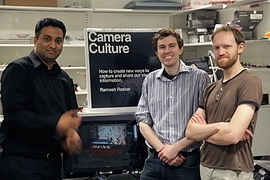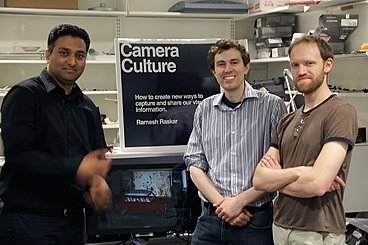Researchers at MIT’s Media Lab have developed a fundamentally new approach to glasses-free 3-D, called HR3D, which they say could double the battery life of devices like the 3DS without compromising screen brightness or resolution. Among other advantages, the technique could also expand the viewing angle of a 3-D screen, making it practical for larger devices with multiple users, and it would maintain the 3-D effect even when the screen is rotated — something that happens routinely with handheld devices.
According to Doug Lanman, a postdoc in Associate Professor Ramesh Raskar’s Camera Culture Group at the Media Lab, the 3DS relies on a century-old technology known as a parallax barrier. Like most 3-D technologies, this one requires two versions of the same image, one tailored to the left eye and one to the right. The two images are sliced into vertical segments and interleaved on a single surface.
By itself, the composite image looks like an incoherent jumble. But if you place a screen with vertical slits in it — the parallax barrier — just in front of the image and stand the right distance away, a 3-D image pops out. The opaque sections of the screen shield the parts of the image intended for the right eye from the left eye, and vice versa, but the slits allow each eye to see the segments intended for it.
The 3DS screen consists of two parallel liquid-crystal displays (LCDs) a small distance apart. When the device is operating in 3-D mode, the front display serves as the parallax barrier, depicting a series of opaque vertical stripes. Since the stripes block half the light coming from the screen, the device’s backlight has to be twice as bright, which drains the battery twice as quickly. Moreover, because the spacing of the stripes is calibrated to the horizontal separation of human eyes, if the screen is tilted, the 3-D illusion disappears.
All the angles
Raskar and Lanman, along with postdoc Yun Hee Kim and graduate student Matthew Hirsch, decided to rethink glasses-free 3-D from the ground up. In the real world, as a viewer moves around an object, his or her perspective on it changes constantly. A convincing simulation of 3-D visual experience, Lanman argues, might require a display that offers a dozen different perspectives as the viewer moves from right to left.
But with parallax-barrier 3-D, each new perspective further restricts light emission. Adding multiple perspectives in the vertical direction as well as the horizontal would require a parallax barrier with horizontal as well as vertical bands. For a display with enough different views, the parallax barrier ends up looking like an opaque sheet with pinholes poked in it.
Like the 3DS, the MIT researchers’ HR3D system uses two layers of liquid-crystal displays. But instead of displaying vertical bands, as the 3DS does, or pinholes, as a multiperspective parallax-barrier system would, the top LCD displays a pattern customized to the image beneath it.
Going into the project, the researchers had no idea what the customized pattern would look like. But once they’d done the math, they found that the ideal pattern ends up looking a lot like the source image. Instead of consisting of a few big, vertical slits, the parallax barrier consists of thousands of tiny slits, whose orientations follow the contours of the objects in the image.
Number crunching
Because the slits are oriented in so many different directions, the 3-D illusion is consistent no matter whether the image is upright or rotated 90 degrees. Adding more perspectives changes the pattern of the slits, but they allow just as much light to pass.
If a device like the 3DS used HR3D, Lanman says, its battery life would be longer, because the parallax barrier would block less light. The 3-D effect would also be consistent no matter the device’s orientation: applications could actually take advantage of screen rotation, particularly in devices that have built-in motion sensors. “But the real win,” Lanman says, “comes with full parallax motion” — that is, a display that shows multiple perspectives in both the horizontal and vertical directions.
“The great thing about Ramesh’s group is that they think of things that no one else has thought of and then demonstrate that they can actually be done,” says Neil Dodgson, professor of graphics and imaging at the University of Cambridge in England, who was one of the reviewers of the paper when it was accepted last year to the SIGGRAPH Asia graphics conference. “It’s quite a clever idea they’ve got here.”
Dodgson points out, however, that HR3D is very computationally intensive. “If you’re saving battery power because you’ve got this extra brightness, but you’re actually using all that battery power to do the computation, then you’re not saving anything,” he says.
While Lanman acknowledges that the algorithm for calculating the barrier pattern that he and his colleagues described in the SIGGRAPH Asia paper is computationally complex, he believes that it can be refined so that “it requires far less computation.” He also points out that special-purpose chips designed specifically to run a refined version of the algorithm would consume much less power than a general-purpose processor performing the same computations.








